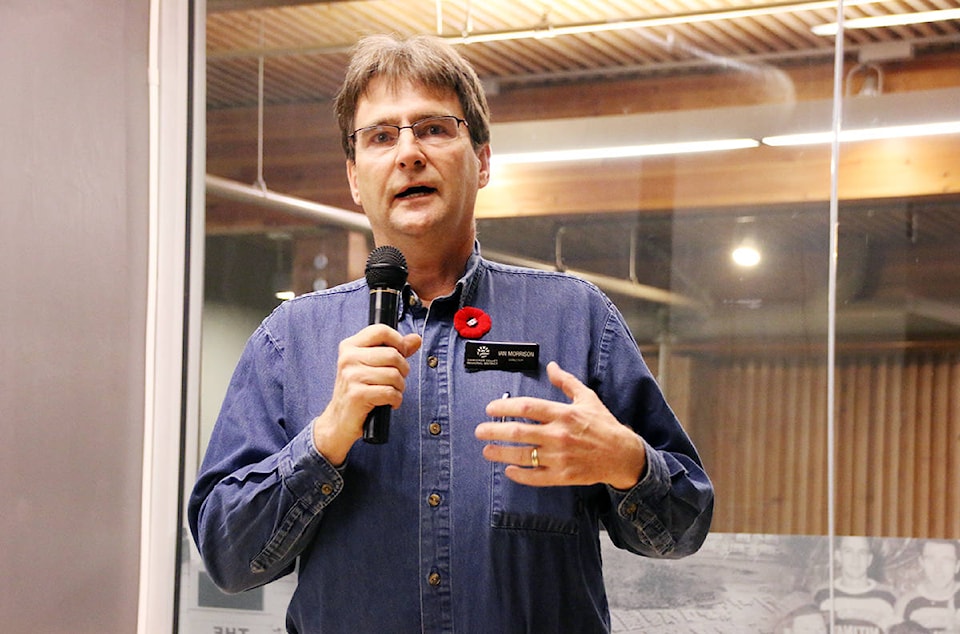Some of the ways to boost the economy of the Cowichan Lake area aren’t flashy but they get the job done, Cowichan Lake South area director Ian Morrison told a chamber of commerce group on Oct. 19.
He, along with a veritable galaxy of local and regional movers and shakers gathered at the Curling Lounge to discuss the economic future for Lake Cowichan and environs.
Morrison stressed the importance of facilities on a community’s potential for growth.
“Has anybody paid a visit to our Cowichan District Hospital lately? It’s kind of sad when you look at it from an infrastructure perspective. We have great staff and great doctors working there but it’s time for a new hospital. [But at] a private meeting held with Health Minister Adrian Dix to put that issue forward, we had a great discussion about Cowichan Valley Hospice, a new project to add a 10-bed hospice unit onto Cairnsmore. This isn’t a flashy exciting thing but the doctors and the nurses told us that just simply taking that 10-bed palliative end-of-life care to another facility is going to start to relieve some of the pressures at the hospital.”
There are many other things that can make the area more attractive to people as well, he said.
“We’ve got this incredible jewel out here called Cowichan Lake to come and experience. I think we can begin to tap into that without some of the resistance that might have been here 10, 15, or 20 years ago when the hopes for a new factory or a new mill were in the forefront of everybody’s minds.
“Behind the scenes, there’s an initiative the regional district is working on, Rural Pathways. Currently, if you’re outside of municipal boundaries, all the roads are maintained by the province and you’re not allowed to do anything in the road right of way. Well, there are important talks going on right now to see about widening the roadway, or if you can’t do that and get walking paths or bike paths, have them as separated paths away from the edge of the road. These are really important issues. Not every cyclist is on a road bike. Some of them are off-road bikes or mountain bikes and we should cater to all of these different groups. But, it’s all about infrastructure.”
Morrison admitted he couldn’t claim credit, but he pointed out that $1.26 million in grants have been approved, aimed at addressing problems with the Mesachie Lake sewer system.
“People may not know that you couldn’t subdivide a lot in Mesachie Lake because there was no capacity in the failing sewer system. When there’s a new sewer filtration area, new pipes in the ground, there will be the possibility for new homes, new businesses in Mesachie Lake,” he said.
“I could ask [the Lake Cowichan councillors present] when they were elected were things like sewers, waterlines, garbage collection going to be important parts of their political career? Believe me, they really are. I know way more about sewer than any normal person should. But it’s that infrastructure that will allow Mesachie Lake to grow,” he said.
“It’s also now become a solid planning principle that five-acre lots with their own well and septic are not a sustainable way to develop communities. You need to develop them around your services: sewer, water, garbage collection. To improve a sewer system is a pretty big thing.”
Another behind-the-scenes way that growth can be optimized is keeping an eye on resources.
“There are great volunteers who are out on the lake every week doing water quality tests, stewards who are protecting this lake. That’s great because the last thing a tourist destination wants is for word to get out that they’ve got a pollution problem in their lake. Now, as well, the CVRD now has a network of air quality sensors, one located at the Honeymoon Bay Hall, one at the Lake Cowichan fire hall, one on west Riverbottom Road and others in Duncan. This is just so that we can track and have good data on the sources of our air pollution.”
And, finally, Morrison had “just a bit of an observation” on what was happening on the ground in his area.
“I have to thank the chamber for their effort and dedication in putting a great kiosk in Mesachie. The community knows about it. It has great information. I think it’s a fantastic spot. Area F parks put some money into putting facilities in there. We’ve got some picnic tables, porta potties, some trees for some shade. But, I can’t tell you how many times I’ve driven home during the summer, got past there and looked down the Pacific Marine Circle route and there will be 30 cyclists standing beside their bicycles by the side of the road at the intersection. It’s the same with motorcycles. They will pull up to that intersection and stop, gather, get off their bikes for a break.
“I think we’ve got a potential partnership opportunity where we have to get a little bit of signage to encourage all those people that are stopping at that dangerous spot to go 100 metres down the road to the infrastructure that’s been put in place with the information, the porta potties, and the picnic tables. These are simple ideas. They wouldn’t be costly, and I think everybody in the community is going to benefit,” he said.
